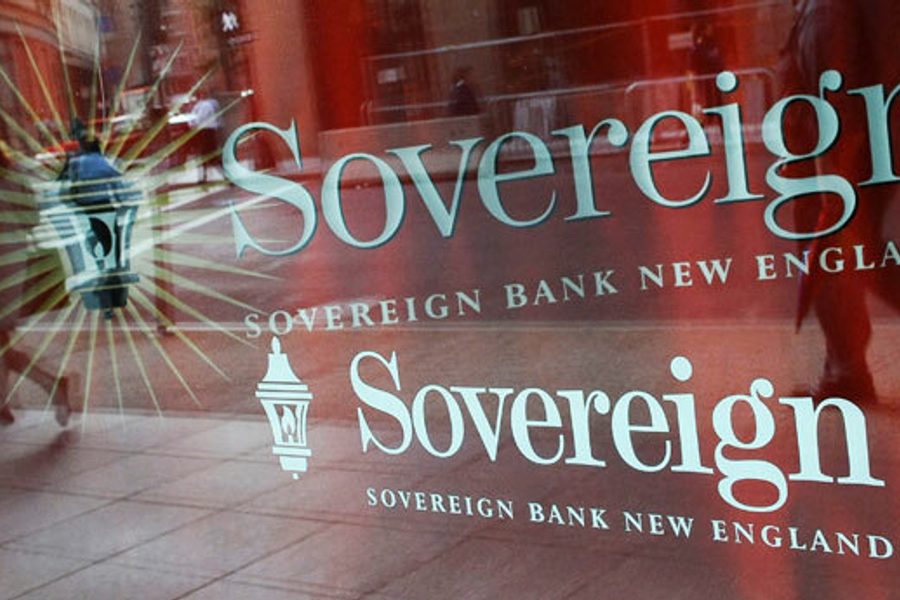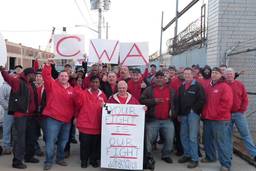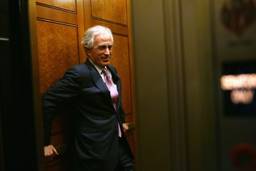BOSTON – Through the blare of screeching feedback from portable translation headsets and microphones, unionized bank workers from Brazil, England, Chile, Germany, and Uruguay are encouraging American workers to undertake an unprecedented campaign against a common enemy: Grupo Santander, the global banking giant which last year took control of Sovereign Bank.
The largest bank in the Euro-zone, where it is based, Santander is the world’s eighth largest banking company by market capitalization. While the company is very good at generating profits around the world (it’s the world’s fourth largest bank by profits), this international meeting is focusing on something else: how the bank’s new U.S. branches might become as unionized as branches in Europe and Latin America.
Santander bank branches are on average 75-percent unionized outside the United States, according to UNI Global Union Finance Director Oliver Roethig because most other industrialized nations have unionized banking sectors. In the United States, however, less than 1 percent of all front-office bank workers are organized. In fact, the unionized janitors working for contractors that clean Sovereign Bank’s headquarters in Boston, Mass., often make more than the bank tellers and personal bankers, whose average wage is $10-$12 dollars per hour, despite individually producing millions of dollars in profits for the bank each year.
But the financial sector, at the center of the U.S. economy, has never been unionized. The international workers and local leaders of the Service Employees International Union (SEIU) and Communication Workers of America (CWA) gathered in July to use the clout of global union federations like the UNI Global Union to give labor a foothold in Santander’s Sovereign operations, and potentially organize the industry from there. If Santander employees are heavily unionized overseas, and corporate profits are so robust, then why shouldn’t American workers also join a union?
Bank reform from the inside
Santander has already responded to the organizing campaign, labor activists say, firing three Boston Sovereign workers in June for organizing activities – Steve Crowley, Janice DeJusi and Gary Rozenas. Crowley, who had worked at Sovereign for 30 years, was honored by the bank this spring for being a top seller, but was fired a week after signing a letter about office problems following Santander’s acquisition of the bank. DeJusi and Rozenas were fired after talking to colleagues about forming a union, according to Andy Kerr of CWA.
Santander has denied discriminating against employees for union activity, saying Sovereign Bank adheres to all U.S. labor laws. A Sovereign spokesperson did not respond to requests for comment on union-busting allegations.
When Santander acquired Sovereign, it immediately laid off 23 percent of its new subsidiary’s workers. The company cut pay, slashed hours and doubled the cost of healthcare for workers. Sovereign workers knew they had to do something, so they approached SEIU last spring to help them organize.
But why would SEIU, which has risen to prominence during the last 25 years in part by organizing janitors, be interested in organizing bank workers?
“Well, it started out in the 1980s; we would organize a building [where janitors worked]… and find out that the management firm that owned the building was really owned by a pension fund, which was owned by an investment firm, which was ultimately owned by a bank,” says Stephen Lerner, the brainchild of SEIU’s Justice for Janitors campaign and now director of SEIU’s Banking and Finance Campaign. “This began a thirty-year process in which we began to discover how much power the big banks have.”
The theory is that if workers gain some control over the banks through the power of unions and the ability to strike, they could have a chokehold on one of the economy’s key sectors. “Our members are facing layoffs as a result of the economic crisis caused by the banks,” says Lerner. They “are screaming out to do something against the banks…scamming them with outrageous bank fees and sub-prime loans.”
The large corporations at the center of the subprime mortgage meltdown, such as Countrywide, often based pay for personal bankers on selling risky products. “The more money I sold you and the higher the rate, the more money I made,” said Donna Feener, a former Bank of America employee who worked in the company’s credit card balance transfer department. “The more outrageous fees and the higher interest loans they can sign you up for, the more workers who have a base salary of only about $10 an hour make.”
The Credit Card, Accountability, Responsibility, and Disclosure (CARD) Act, signed into law last year, banned banks from automatically enrolling people into accounts with overdrafts fees, which make the bank industry $38 billion a year, according to the Financial Times. Many workers now feel pressure to meet strict quotas for signing people up for accounts with high overdraft fees.
To meet her quotas, former Bank of America worker Nancy Sorto would often go to public places to sign people up for checking accounts. “I would have to work ten or twelve hours a day trying to meet these goals, but I would only be paid for eight,” Sorto said.
“The real irony is that the workers who do customer service that actually tries to help people in banks are treated the worst, while the bankers on Wall Street who do things that hurt people are paid huge bonuses,” Greater Boston Labor Council President Louis Mandarini said at a community meeting in Boston to gather support for organizing bank workers this July. Indeed, for just 3.6 percent of the cost of the bonuses paid to Wall Street executives, the salaries of America’s nearly 550,000 bank tellers in the country could be increased by $2 an hour, and fully employer paid health insurance could be provided to all of them.
Labor activists believe that if bank workers could join a union, workers would have more power in reshaping the way banks treat consumers. And that could prevent the proliferation of risky lending practices, which triggered the current crisis.
“By demonstrating the interrelationship between deregulation of the banks, banks’ abuse of their own workers and consumers, and the subsequent crash of the economy,” Lerner argued in a recent New Labor Forum article, “we can develop a campaign that captures the imagination of an angry public, challenges the power of Wall Street and leads to substantive fixes for the American economy.”
A global response to a global industry
Lerner is considered one of the whiz kids of the labor movement, but the idea of organizing the banking sector was not his own. The impetus came from the Brazilian Bank Workers Union, CONTRAF, which has a large presence within Santander. (The bulk of the company’s Latin American operations are in Brazil.) Eighty percent of Brazilian bank workers are organized, and they work six hour days and enjoy 30 days of vacation a year.
Brazilian workers are so powerful, in fact, that Brazilian President Luiz Inácio Lula da Silva tapped union leader Paulo Bernardo Silva to be the head of the country’s Ministry of Planning. This is the equivalent of President Barack Obama replacing National Economic Council Director Larry Summers with AFL-CIO President Richard Trumka. As the U.S. labor movement struggles just to confirm labor lawyers to the National Labor Relations Board, that’s something unionists here can only dream about.
But CONTRAF workers’ power is now threatened. As bank managers are transferred to Santander operations outside of global finance capitals (New York, London), they are taking practices learned there with them. Santander managers are now trying to force employees outside of the United States in both Europe and Latin America to adopt a quota system in which pay is linked to a worker’s ability to sell sub-prime products with hidden fees.
“For the last 10 years, workers have been coming to these international labor conferences and insisting that we organize bank workers in the U.S. because they are so threatened by U.S. practices,” Lerner explains. “It’s perhaps the first time in the history of the U.S. labor movement where foreign unions have been the driving force behind launching an organizing drive of this nature in the U.S.”
Labor’s ability to organize bank workers isn’t just crucial to changing the economy, it’s crucial to reviving a labor movement whose private sector membership has fallen below 8 percent. With the popularity of U.S. unions at a 70-year low – a Pew survey this year showed that unions had a favorability rating of 41 percent, down dramatically from 58 percent in 2007 – and with the left and right still anger at bailed-out banks, Lerner believes the labor movement could find widespread support for organizing bank workers to fight unfair practices. It’s certainly possible: The U.S. labor movement has seen its greatest gains – the obvious example being the 1930s – when organizing was done in concert with mass social movements.
“We are protesting outside of banks nearly every week, [and] we would love to picket for workers rights,” said one person attending the Boston meeting in July.
There’s a way, but is there a will?
The problem is that bank branches are difficult to organize. Although it might seem an unlikely comparison, the situation is analogous to that of another economic mover and shaker – Wal-Mart. Like the retail giant, large banks can easily shut down branches and move them down the road if workers vote to unionize.
In order to organize the banking industry, SEIU would have to make some sort of organizing agreement with Santander. But thus far, company officials have refused to even meet with UNI Global Union, which represents 237 trade unions and 3 million workers in the finance sector worldwide, to discuss ensuring free and fair union elections in the Boston-area branches of Sovereign Bank.
But Sovereign workers have more leverage against their bank than Wal-Mart workers do against their company. Boston City Councilman Felix Arroyo, a former SEIU political director, is currently working on a resolution that would threaten to move tens of millions of Boston city government money out of Sovereign Bank if the company doesn’t agree to allow workers to hold a free and fair union election. The workers have even won the support of powerful Boston area congressman Barney Frank, who vowed in July of this year to use whatever power he can as chairman of the House Financial Services Committee to force banks to allow elections.
Given that big banks faced a tidal wave of public outcry over bonuses last year and still did as they pleased, it’s important to remember that the workers have beaten the banks before. The post-bailout financial reform movement was in part launched when workers at Chicago-based Republic Windows and Doors occupied their plant in December 2008 to protest Bank of America’s role in closing their factory without notice.
“Among the many lessons of the Republic occupation was that in order to beat the banks you needed three things: a good case, political support, and workers willing to take bold action,” says Chris Townsend, of the United Electrical workers union, to which Republic workers belonged. “The banks came to the table when the entire world could see that the union was going to do whatever it took to win, pay whatever price, for as long as it would take.”
Former CWA staffer and labor journalist Steve Early believes unions have sabotaged some of their own campaigns because they suffer from what he terms “organizational attention deficit disorder.” “You can’t develop new forms of organizing with any real potential for overcoming corporate opposition…if you constantly flit from project to project,” Early says. “These efforts require a long-term commitment that few unions are willing to make, even when dealing with a strategic multinational target that’s not going away.”
So the crucial question is: Will SEIU be willing to pay whatever price necessary to organize bank workers?
In the post-Andy Stern-era of SEIU, the union is showing a new willingness to work with other unions and community groups. CWA organizers (which is not part of Change to Win, the breakaway labor federation Andy Stern spearheaded five years ago) say they were surprised to be invited this summer into the bank workers campaign by SEIU so early. (The campaign began this spring.)
But most promising is SEIU’s decision to allow foreign unionists to be a driving force behind an American organizing drive. The Boston bank workers campaign is still in its infancy, but Brazilian trade unionist delegations have already made two trips to Boston, in May and July of 2010, to encourage Sovereign workers. I accompanied Brazilians as they entered bank branches and asked employees to attend organizing meetings. “We are willing to make as many trips to Boston as they need to and do whatever it takes to help organize workers,” CONTRAF President Carlos Cordeiro says.
Ironically, the very same Latin American trade union movements that suffered as a result of pro-Cold War policies of the American labor movement are now coming to the rescue of the American labor movement. Securing free and fair union elections in U.S. banks will depend in large part on the ability of bank unions overseas to extract international enforceable organizing agreements from companies like Santander.
With the help of Santander employees already organized overseas, bank workers in Boston just might just be able to form a union – and suggest a way to revitalize a U.S. labor movement now barely present in the private sector. Lerner summarizes the challenge ahead: “We need to be committed to figuring out how we organize whole sectors. The starting point is to organize the banking sector, to…look at the most important part of the economy.”
Put simply, the banks are too big not to unionize.









